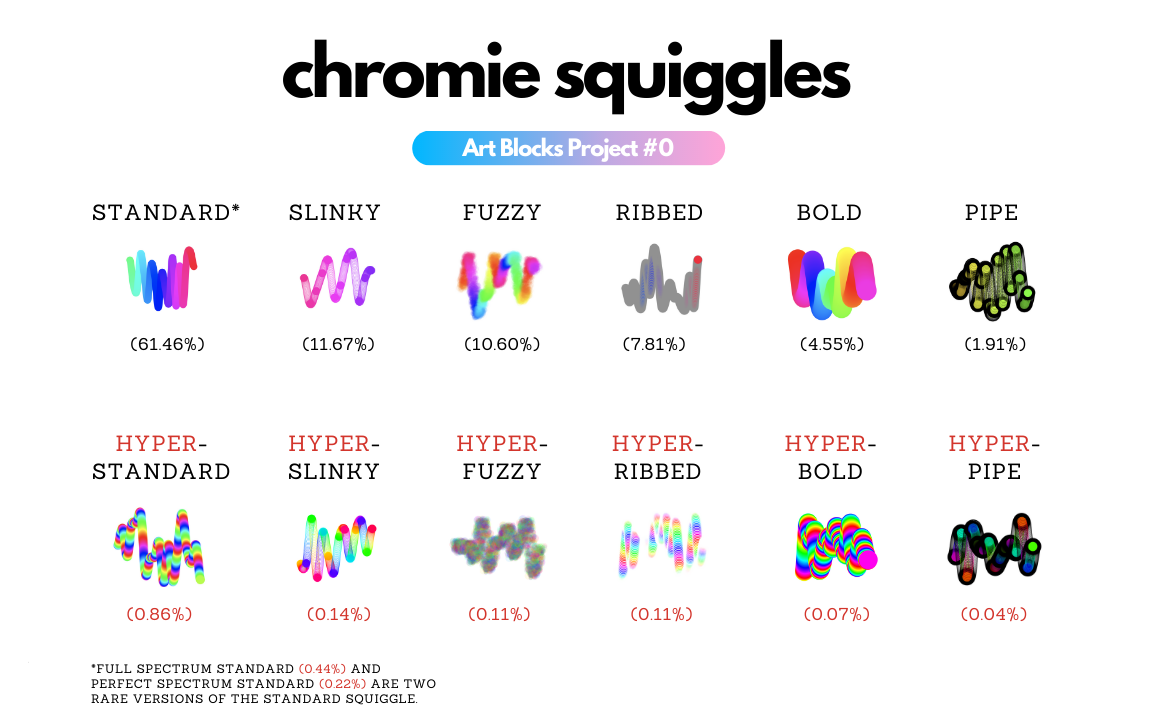
The Evolution of Generative NFT Art: The Story of Chromie Squiggles
A squiggle and a keystroke
Surprisingly, Coachella was the inspiration for Chromie Squiggles, Art Blocks’ most notable NFT collection — and, arguably, the Art Blocks NFT marketplace itself. When Art Blocks Founder Erick Calderon, better known as Snowfro, saw Amon Tobin’s set at Coachella 2012, he fell in love with the art on display.
What he saw was generative art, specifically projection mapping. And it made Snowfro consider how its limitless potential could aid in the advancement of artistic expression. “If I had to pinpoint a moment in time when I realized I could become an artist myself, it was there,” he told Bright Moments.
“The way projection mapping and light was used in Tobin’s show made me think that I could do something similar. Art does not have to be manual; it can be immersive and technological.”
So, how did Snowfro go from being an awestruck fan on the Coachella festival grounds to being the author of one of the most significant generative art collections seen in the NFT space thus far?
Snowfro worked in the tile industry before becoming Art Blocks’ creator and steward, as detailed in an article on Right Click Save. In his spare time, he practiced coding and creating models for generative art. However, it took him years to realize how experiments in generative art could lead to a full-time career in the arts.
He realized that NFTs held the key to unlocking the full potential of generative art in a modern, democratized context after discovering CryptoPunks in 2017 (when it was only $35 per mint in gas fees).
“When I claimed some CryptoPunks on that day, I realized that there was this moment where you have the ability, maybe for the first time in history, to prove ownership of something digital. And it piqued my interest,” Snofro said in a video interview with nftnow. “And all of a sudden, all of my previous history and creative coding and immersive art installations came together with this idea that you could own something digital. “Yeah, I think the blockchain would be a wonderful way for generative art to be distributed,” I just kind of thought.
He began work on what eventually became Art Blocks, a mainstay in hosting cutting-edge generative NFT art, by combining his desire to create a truly blockchain-native experience with his love for generative art. To fund this venture, he sold 34 of the CryptoPunks he’d minted following the launch of Larva Labs.
Following the release of Art Blocks, Snowfro faced a new challenge. He required a project that would demonstrate the truly unique user experience. Unlike most NFT marketplaces, Art Blocks pieces do not exist until they are purchased and minted. Collectors receive an unfiltered output corresponding to the generative script originally provided by the collection’s artist when they purchase a piece from any collection hosted on Art Blocks.
That is, the pieces are not “pieces” in and of themselves, but rather the results of a script. The number of times a script is set to produce an output limits collection sizes, and the rarity of each “piece” within can only be truly revealed once minting has finished.
Unpacking the Chromie Squiggle NFTs
That is how the Chromie Squiggles NFT collection came to be, which is currently one of only two generative art collections created by Snowfro. After all, who better to demonstrate Art Blocks’ capabilities than its creator? Snowfro prepared the script for Chromie Squiggles ahead of its release, offering collectors 9,000 chances to claim an output from his script at launch. Initially, the collection was intended to serve as a proof of concept for Art Blocks’ unique approach to generative art. However, the scope of Chromie Squiggles expanded significantly over time.
“It’s completely messed up my life,” Snowfro said. “It’s fascinating to see how people have embraced this as a symbol of generative art.” Despite the ease with which the NFT space’s generative art community embraced this unassuming collection of squiggles, Snowfro hopes that generative artists seeking to have their voices heard in the space will not be constrained into believing that Chromie Squiggles represents them entirely. Given the more intangible aspects of Chromie Squiggles’ legacy, it’s a sympathetic and fitting one. “But it is nice that within the space this is like the sign of empathy. It’s a sign of compassion [as well as] general inclusivity in the space. I believe the universe yearns for a little bit of humanity as well.
So the way people have embraced the Chromie Squiggles has taken me completely by surprise. “I’m very proud of myself, and I’m very excited to see where it goes from here.”
However, if you want to create a new Chromie Squiggle, you must go straight to the source. As of writing, there are only 756 Chromie Squiggle NFTs left to be minted, with all keys for mints currently in possession of Snowfro to “give out as he pleases,” according to the Chromie Squiggles website.
Fortunately, the Chromie Squiggles website mentions a thriving secondary market for these NFTs. They will not, however, be cheap. Although not every Squiggle will sell for the $2.44 million that one buyer paid for Chromie Squiggle #3984, the collection’s floor prices are currently north of 13.5 ETH (keep in mind, this does not account for Chromie Squiggles’ rarity).
The twenty “perfect spectrum Squiggles” that display exactly 256 hues are at the top of the Chromie Squiggle value spectrum. Snowfro’s code has enabled a plethora of possibilities for would-be minters upon minting a Chromie Squiggle, despite the collection’s deceptively simple appearance.
While even the collection’s website admits that Chromie Squiggles cannot always compete with the traditional (museum-based) artistic experience, this collection has nonetheless helped to develop and recognize one of the most important scenes in NFT art today. Users can join the Chromie Squiggles community by purchasing a fraction of a Chromie Squiggle through its DAO, joining the ranks of a community centered on guiding the generative artists of tomorrow to continue developing this growing subset of NFT art.

